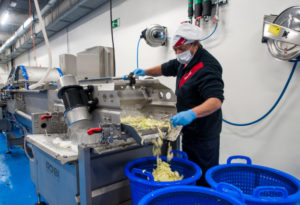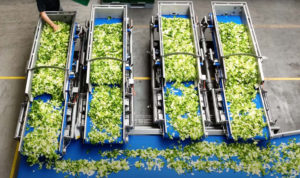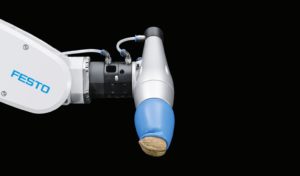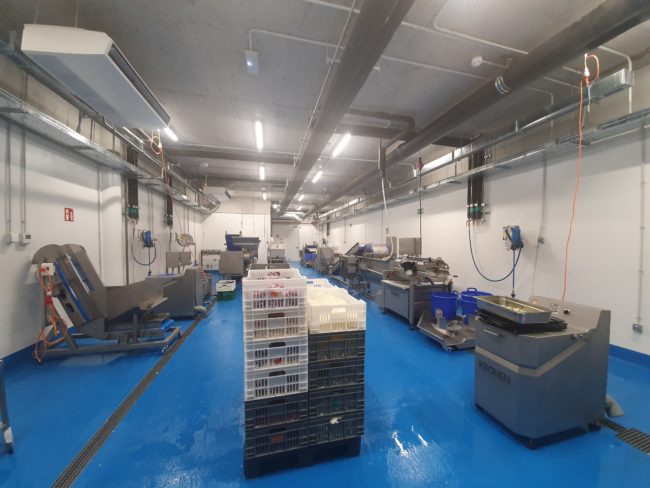Starting a processing line: Plan, plan and plan some more
Washing, slicing, dicing, chopping and peeling are just some terms that come to mind when talking about frozen and fresh produce processing. But do you know how to start, and what you need to do, before you chop, dice and slice?
We spoke with produce specialists from Kronen and Steve Bain, industry segment manager, food and packaging at Festo, who offered some advice on how one would start a processing line ― and eight tips on decision-making.
Q: When starting a produce processing line, what is the first thing a company should do?
Kronen: Be clear for yourself on who your customers will be/what market you are going to serve. This should be the starting point of your planning as it does influence so many decisions along the way and is the base for how your whole setup will look.

Bain: Know what your final capabilities will look like and work backward from there. Produce doesn’t really need to be automated; production time is still very manual for produce. Thinking about making the leap — how big do you want to do it? Plan for where you want to go.
Q: How about creating a floor plan or line layout?
Kronen: When starting, and of course this depends on future plans and at what level they are starting, one should plan the processing area in a way that future expansion is easily possible. Also, it is important to take a good and easy product flow through the line into account. Which means that product should flow in one direction through the process. Separation of a low-risk area and a high-risk area wherever possible should be considered.
Bain: For sure have a floor plan. You don’t have to do it all at once. For instance, you can still do manual palletizing, until you want to automate. Then you will have room for it.
Q: What about flooring materials – does that matter, and why?
Kronen: Flooring materials are part of the big puzzle that have many aspects that need to be considered along a fresh cut processing line. Without the right floor material and a decent floor drains system, a hygienic production of fresh cut is not really possible and all other efforts along the line will not be able to make up for this.
Bain: Floors can harbor bacteria. One plant used to process ice cream on their brick floor, and then it got bacteria in it. Just pay attention to flooring. Know what you need before making a selection.
Q: Should a facility have worker sanitation areas and cleaning stations on the plant floor?
Kronen: Sanitation is the base for a safe processing of fresh produce. This includes the processing area, the produce itself and of course, also the workers. Sanitation areas for them are crucial to avoid/reduce cross-contamination risks. Additional hygiene stations on the entry and exit of the working areas are necessary. Here one should consider different levels on low-risk and high-risk processing areas.
Hygiene is an important part of the total setup. Hygiene for workers, product and of course also the equipment and the production area and therefore cleaning stations in the processing area are a must.
Q: What equipment should someone wanting to start produce processing look for?
Kronen: Equipment is only one piece in the big puzzle and not a game-changer alone. On the other hand, it is important to choose an equipment supplier based on a long-term relation which you will have when using the equipment every day to fulfill the expectations of your customers. In this respect it is, of course, helpful to have as few equipment suppliers as possible and, even more importantly, someone that will support you also after the equipment is installed.


When starting a processing line, the focus should be on equipment that allows you to add on to the line step by step when your business grows, as only then the business is paying off the investment. The focus in the beginning should be on machines that are difficult to replace with people.
Our recommendation is always to invest first in cutting and spinning equipment as peeling, transport, washing and packaging are steps that can be done manually or with simple solutions when starting. Of course, it is always better to have the full set as equipment reduces labor cost, allows more consistent quality and more control over the different steps, and last but not least, a more professional look of the final packed product. Unfortunately, a company’s budget doesn’t always allow investment in a full processing line and, as mentioned before, machinery is only one part of the total picture. To have a successful production, every part along the line needs to be done right.
Bain: The concept changes from produce type to produce type. In early stage produce facilities, conveyors have someone unloading, picking off conveyor, etc. For automation, it depends heavily on where in the process — and what type of produce. But we’ve seen sorting and grading of produce being automated. Is it ready for the shelf or does it need a couple of days? Vision systems are used in these types of equipment. There is more value with it — produce is higher quality when it goes to market, while also reducing labor and increasing speed.
We sell sorting machine builders, high- speed valves, larger air cylinders to kick out potatoes or bad tomatoes. You can automate a drop chute and an arm to pick and place product.

8 tips for starting out
- Be sure that you know when starting your planning who your customers will be and which market segment you want to have your (first) focus on.
- Understand that for a good quality product, you need to have the complete process in mind, from raw material supply to delivery to the customer. The chain is only as good as its weakest link.
- Make sure you plan enough space for every part of the process when thinking about the layout and size of your production facility: storage of raw material and finished goods, processing area(s), offices, sanitary areas, change rooms etc.
- Try to learn from others. If you do have the possibility to visit an existing facility and have a conversation with people doing what you plan to do, it will make your life much easier. In the end, it is the people running the business on every level within the facility that make the difference between success and failure.
- Do not just look where you can get things cheapest. It’s better to plan on where, based on your experience in this field, you can profit from a good relationship with your supplier. Investment is not only a one-time thing. Running costs and reliability are more important over time.
- Understand that processing of produce needs good quality to go in to get good quality out.
- For fresh produce processing, it is quite often necessary to look for suitable raw material to get the shelf life and quality your customers are looking for.
- Make yourself aware of regulations when applying for your planned business.
— Kronen







